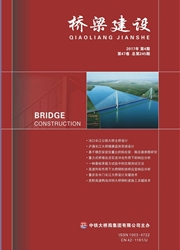

 中文摘要:
中文摘要:
南宁青山大桥主桥为主跨430 m 的双塔混合梁斜拉桥,桥塔采用钢筋混凝土异型换 结构,塔柱采用全自动液压爬模施工,施工中沿塔柱高度方向布置了 5 道临时横撑.为有效控制施 工过程中桥塔的变形和应力,提出 4 种( 3 种水平横撑和1 种“横撑+ 斜撑”)临时横撑方案,采用 ANSYS软件建立桥塔的空间有限元模型,模拟桥塔施工全过程,分析临时横撑和塔柱的位移和应 力.结果表明: “横撑+ 斜撑”方案的临时横撑横向和竖向位移最小,受到的应力水平最低,最能有 效控制桥塔的应力和变形.因此,采用“横撑+ 斜撑”方案.分析该方案下横撑对桥塔的位移和空 间受力影响可知:塔柱的压、拉应力分别控制在10. 0 M P a和 0. 7 M P a内;桥塔横桥向最大位移为 7.8 mm ,倾斜度约为1 /1 7 6 0 0 ,均满足施工要求.
 英文摘要:
英文摘要:
Th e main b ridg e of th e Qin g sh an Bridge in Nan n in g is a d o u b le-p y lon h y b r id g irde r cable-stayed br idge wi th the main span of 430 m. The pylons of the br idge are the reinforced con-crete special-shaped arch pylons and the pylon columns were const ructed, using the automat ic hy-draul ic climb formwork. In the const ruct ion, 5 temporary crossing bracings were arranged for a pylon along the height of the pylon columns. To effectively control the deformation and st resses of the pylons, 4 schemes of the crossing bracings (3 types of the hor izontal crossing bracings and 1 type of the cross bracings + diagonal bracings) were proposed. The sof tware ANSYS was used to establ ish the spatial f inite element model for the pylons, the whole construct ion processes of the pylons were simulated and the displacement and stresses of the crossing bracings and pylon col-umns were analyzed. The resul ts of the analysis demonst rate that the transverse and vert ical dis-placement of the scheme of the crossing bracings + diagonal bracings is the least , the stress levels are the lowest and wi th the scheme, the st resses and deformation of the pylons can be control led most effectively. In that case, the scheme is selected. From the analysis of the inf luences of the lower cross bracings in the scheme on the displacement and the spatial force condit ions of the py-lons, i t is known that the compressive and tensi le st resses of the pylon columns are respect ivelycontrol led wi thin 10. 0 MPa and 0. 7 MPa. The maximum displacement of the pylons in the trans-verse direct ion of the bridge is 7. 8 mm, the inclinat ion is about 1/17 600 and the displacement and inclinat ion can all sat isfy the construct ion requirements.
 同期刊论文项目
同期刊论文项目
 同项目期刊论文
同项目期刊论文
 期刊信息
期刊信息
